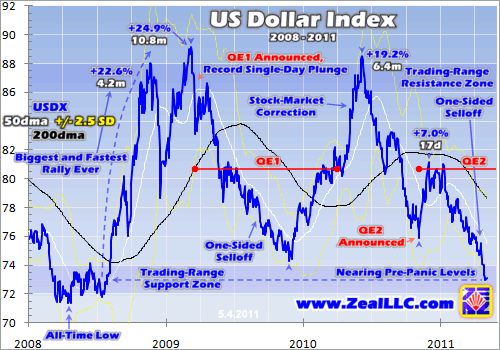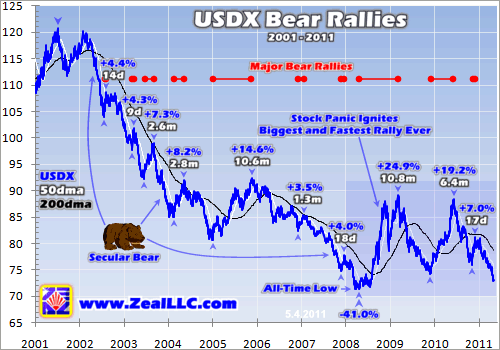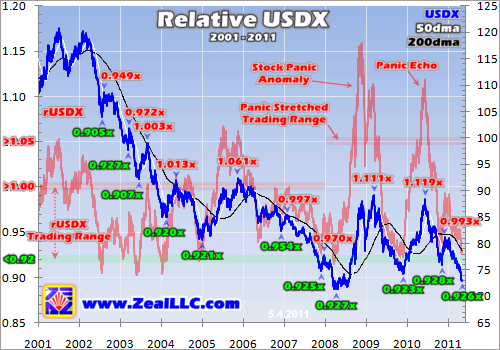|
|
|||||||
|
|
|
|
|
|
|
|
|
|
US Dollar Bear Rallies 2 Adam Hamilton May 6, 2011 2740 Words
The beleaguered US dollar has certainly challenged silver’s crown of being the most-one-sided trade lately. The bearishness and pessimism plaguing the world’s reserve currency is overwhelming and universal, with nearly everyone convinced the US dollar is ready to fall off a cliff. But it is psychological conditions just like today’s that birth mighty bear-market rallies, with widespread implications for traders.
I certainly understand the bearishness permeating the US dollar today, as its fundamentals truly are rotten. On the supply side, Washington is spending like there is no tomorrow so Bernanke’s lapdog Fed is obsequiously creating vast amounts of new dollars out of thin air to monetize the federal government’s ballooning debt. This spiraling inflation is leading to an exploding US dollar supply, and of course the more plentiful anything becomes the lower its price drifts in the global marketplace.
And this surging supply is being met with dwindling demand, compounding the problems. Thanks to the Obama Administration’s mind-blowing deficit spending and debt growth, foreign investors are losing faith in the government backing the world’s reserve currency. And the Fed, by artificially holding interest rates at zero, has destroyed all profit incentives for investors to buy dollars. Meanwhile major central banks are diversifying out of their massive US dollar holdings, which still dominate their total reserves.
Lower demand, less capital bidding on anything, also leads to prices drifting lower. So with the US dollar’s rapidly-increasing supply and waning global demand, the fundamentals unanimously continue to support this sick currency’s decade-old secular bear. Nevertheless, even the longest-lived and most-powerful bear markets, with impeccably-bearish fundamentals, witness major bear rallies erupting in their midst from time to time. The US dollar is certainly no exception.
Bear rallies are not driven by fundamentals, but by technicals and sentiment. After a price drifts relentlessly lower for long enough in an in-progress bear, technicals and sentiment become very unbalanced. Prices reach very oversold levels, having fallen too far too fast. Thus traders become utterly convinced that this long drift lower will accelerate into something more, a rapid panic-like plunge from already-weak levels. The quickest way to rebalance away these extremes is through sharp bear-market rallies.
As you will see in these charts, not only are dollar bear-market rallies fairly common over the past decade, but the dollar is once again at levels today that ignited these healthy countertrend reversals in the past. The definitive way to measure the US dollar is through the popular US Dollar Index (USDX). Born way back in early 1973, it measures the US dollar against a trade-weighted basket of 6 major world currencies. The euro dominates it at 59% of its weight, followed by the Japanese yen at 13% and the British pound at 12%.
This geometrically-averaged index measures the progress of the US dollar in the world markets just like the S&P 500 stock index measures the progress of the US stock markets. Thus in the rest of this essay, the word “dollar” is usually interchangeable with the USDX. This first chart looks at the US dollar over the past few years, since the epic 2008 stock panic that ignited a radical rally in this currency.
This post-panic perspective is very important for multiple reasons. First, it shows that the US dollar surges due to safe-haven demand whenever the US stock markets fall fast enough to generate some real fear. Cash is king when the stock markets are selling off hard! Second, many momentum traders today argue that the US dollar can’t rally as long as the Fed is pumping out trillions of new dollars with its quantitative-easing campaigns. This assertion is not only untrue, but easily disproved.
Back in April 2008 well before the stock panic, the USDX hit an all-time low. This supposedly-mighty currency had fallen an embarrassing (for Washington and the Fed) 41.0% since this secular bear began way back in July 2001! Incidentally at that time when this currency was universally-loved, I predicted the upcoming dollar bear. This ultra-contrarian call, and my parallel admonition to buy “physical gold and quality unhedged gold stocks”, earned our subscribers fortunes in the decade since.
Starting in July 2008 a bond panic morphed into the first true stock panic in 101 years, an event that drove fear to previously-unimaginable extremes. This precipitous stock-market selling (the flagship S&P 500 plummeted 30% in just one month!) drove epic safe-haven demand for US dollars worldwide. Thus the USDX erupted in its biggest and fastest rally ever, rocketing 22.6% higher in just over 4 months!
While that particular bear rally was supremely atypical since a once-in-a-century extreme-fear event ignited it, it perfectly illustrates what I call “the panic trade”. Ever since then, whenever the stock markets fall fast enough to generate significant fear traders rush to dump all their risky assets (risk-off) and flood into cash, US dollars. And since foreign stock markets follow the lead of the US stock markets, their investors dump their local stocks simultaneously and then go a step farther by selling their local currencies to park in US dollars.
If you want to learn more about the ironclad post-panic relationship of stock selling driving dollar buying, I recently wrote a whole essay explaining it. But for our purposes today, realize the catalyst that triggers an oversold dollar erupting into a sharp bear-market rally is often falling US stock markets. This is very relevant today given how overbought the S&P 500 has been, and how complacency and greed have utterly permeated it.
Soon after the secondary stock-panic low in March 2009, Ben Bernanke’s Federal Reserve announced its now-infamous quantitative-easing scheme of printing dollars to monetize debt. There is no doubt QE is wildly bearish fundamentally. The very day QE1 was announced in March 2009, the USDX plunged 2.9% in its worst single-day loss going back decades to at least 1985, if not ever! Subsequently QE1, combined with rallying stock markets (risk-on) enticing traders out of cash, weighed heavily on the dollar for most of the rest of 2009.
But by November 2009, despite QE1 still being in full force, the USDX had simply been selling off for too long. Fundamentals were indeed bearish, but still technicals grew too oversold and sentiment too pessimistic. So a very-sharp bear-market rally erupted despite QE1. Months later in March 2010 this big rally was slowing and starting to roll over since the dollar’s sentiment had indeed been rebalanced. But right then a major stock-market correction bloomed that reignited safe-haven dollar demand and greatly extended this currency’s bear-market rally.
It ultimately climaxed at a huge 19.2% gain over a half-year or so. As is often the case, the USDX happened to top the very day the stock markets bottomed in June 2010. Provocatively the dollar was actually very overbought then! Traders were too optimistic about it and believed all the irrational euro-to-zero arguments spawned by the extreme euro fears of the time. So the dollar’s bearish fundamentals soon regained control of its price trajectory.
Then in early November 2010, the Fed formally announced the birth of QE2. Yet despite another record monetization of US Treasuries, the dollar actually blasted 7.0% higher in just over 3 weeks! Fundamentally this makes no sense at all since quantitative easing is very bearish for this currency. But since the USDX was oversold and traders were far too pessimistic, a sharp bear-market rally ignited anyway to rebalance sentiment. Over the short term, technicals and sentiment trump fundamentals.
And now once again today we find ourselves in a similar technical position to where the past few years’ dollar bear-market rallies have erupted. Right now the dollar is very oversold and sentiment is extremely bearish after its long one-sided selloff so far in 2011. The USDX is back down near pre-panic levels, in the support zone of its post-panic trading range. So despite the fact that QE2 is still in force, the dollar’s technicals and sentiment point to a massive and imminent bear-market rally.
And these necessary and healthy events are certainly not just a post-panic thing. This next chart zooms out to the dollar’s entire secular bear since mid-2001. Just as bull markets don’t rally in a nice straight line indefinitely, neither do bear markets fall in a nice straight line. Like bull markets are interrupted with periodic corrections to rebalance sentiment, so are bear markets interrupted by periodic bear-market rallies for the same reason. These countertrend reversals are fairly common, and super-important for traders.
The red lines highlight when major bear rallies in the USDX were underway, and they capture a surprisingly-large slice of cumulative time since mid-2001 despite the overpowering secular-bear trend. Note that before the wildly-anomalous dollar bear rallies since the stock panic, these countertrend reversals were usually much smaller and shorter. We are talking +4% to +8% over a month or two, nothing crazy. Yet every single one of these dollar bear rallies had a major impact on commodities prices.
All the headline commodities are nearly universally priced in US dollars. So when the dollar surges in one of its periodic bear-market rallies, its impact on commodities is often large. A stronger dollar, however temporary, means it takes fewer to buy a unit of any commodity. So commodities prices fall in dollar terms. And of course when commodities prices are falling, commodities stocks usually get hammered lower. So if you invest in or speculate in commodities stocks like we do, you have to be wary of USDX bear rallies!
There are a couple more provocative observations in this chart. Note that the USDX has witnessed major bear rallies in every single year of its secular bear. But we haven’t seen one in 2011 yet, so the odds are favorable that it is coming. In addition, for the most part the time between these bear rallies doesn’t extend much beyond 6 months. The last USDX bear rally peaked at the end of November 2010, so we are certainly entering the timeframe where the next dollar surge is increasingly likely.
I have one final chart to share on dollar bear rallies. This one uses the very-successful Relativity trading system I developed many years ago. It looks at the USDX levels relative to its 200-day moving average, which over time form a horizontal trading range. When the multiple known as the Relative USDX (rUSDX) gets too low in this trading range, another bear-market rally is highly probable.
Prior to the stock panic, the top of the USDX’s relative trading range was 1.00x. Since this metric is computed by dividing the daily USDX close by its own 200dma, 1.00x means the USDX is right at its 200dma. And indeed in ongoing bear markets, this key moving average is the highest-probability zone for a countertrend reversal (bear-market rally) to fail. But thanks to the crazy stock-panic anomaly, we had to raise the upper resistance of this relative range to 1.05x in recent years.
But for today’s purposes resistance isn’t very important, because the rUSDX is now near support at the lower end of its trading range. Last week this indicator fell to 0.926x, meaning the USDX had slumped to 92.6% of its own 200dma. 0.92x has always been the bottom of the rUSDX’s relative range because so many major bear-market rallies have erupted from there. The relative levels at the beginnings and ends of every major dollar bear rally shown on the previous chart are noted in this one.
Check out all the green 0.92x levels. Out of the 10 major dollar bear-market rallies in the past decade, fully 7 ignited when the US Dollar Index had slumped to near 92% of its 200-day moving average! And every major bear rally since the stock panic was born near 0.92x. So to see 0.926x last week for the first time since the birth of the last major bear rally in November 2010 is a powerful portent. The odds heavily favor another major bear rally erupting right now.
Obviously these major countertrend reversals have huge implications for currency traders, but most investors and speculators aren’t involved in that realm. So why should you care? Because big dollar bear rallies affect many other markets, especially dollar-denominated commodities. These include all the popular commodities traders love including gold, silver, oil, and copper. Dollar bear rallies hit these commodities, and others, very hard.
Rapidly-falling commodities prices driven by a USDX bear rally, no matter how short-lived, usually lead to brutally-sharp selloffs in the stocks of the companies that explore for and produce these raw materials. So watching the US dollar’s technicals and sentiment to know when probabilities start favoring major bear rallies offers huge advantages to investors and speculators alike.
While investors probably won’t sell commodities stocks in anticipation of a dollar rally, knowing one is likely still helps gird them psychologically. When you expect a correction, you are far less likely to get scared into selling at the wrong time than you would be if the correction was a total surprise. Also, long-term investors deploy new capital from time to time from their surplus income. And immediately after commodities corrections driven by dollar rallies is the perfect time to add new positions at relatively-low prices.
And foreknowledge of major dollar bear rallies is an even-greater boon for speculators. It helps us decide when to exit short-term commodities and commodities-stock trades near highs to maximize profits. Realizing profits and building cash positions before a USDX bear rally ignites leaves speculators perfectly positioned to buy the subsequent bargains once the temporary dollar reversal runs its course. Combining dollar technicals with individual commodities’ greatly enhances timing for all trades.
Far too often traders get myopically fixated in their own little realm, ignoring external markets that affect it. But the global financial markets are heavily-interrelated, with capital sloshing around between stocks, bonds, currencies, and commodities constantly. One market becoming very overbought or oversold can really affect other markets, driving big sentiment swings that translate into big price moves elsewhere. And these inter-market relationships can easily override underlying fundamentals, temporarily at least.
Let’s use silver as an example, it’s been a red-hot market full of zealous traders who live, eat, breathe, and sleep nothing but silver. All they talk about is silver fundamentals. But as I warned in March, stock-market selloffs heavily weigh on silver. There is no fundamental reason, this link is purely sentimental. Stock selloffs generate universal fear that spills into silver, leading traders to sell it aggressively. And dollar rallies hit all commodities, including silver. A trader so fixated on silver, or any market, that he can’t consider major external influences is going to have a tough time buying low and selling high.
This is why we’ve always taken a big-picture approach at Zeal. We are definitely students of the fundamentals driving the core secular trends. But we also constantly evaluate the technical and sentimental situations in interrelated markets that affect our commodities-stock trades. Obviously this includes the state of the US dollar. This holistic approach has been wildly profitable, helping to optimize trade timing. Since 2001, all 583 of our newsletter stock trades have achieved stellar average annualized realized gains of +52%!
To thrive in the stock markets, you have to digest and correctly analyze a broad array of fundamental, technical, and sentimental data from multiple markets simultaneously. All of these inputs have to be weighed in probability-theory terms, to understand the most-likely outcomes. We do this constantly, and have grown very good at it after decades of practice. We share the profitable fruits of our hard work and resulting trading recommendations (when the timing is favorable) in our acclaimed weekly and monthly subscription newsletters. Subscribe today, and start understanding the big picture and thriving!
The bottom line is despite the US dollar having terribly-bearish fundamentals, it still experiences big and fast bear-market rallies from time to time. These are purely technical and sentimental events. After any price falls too far too fast, it simply gets too oversold and psychology gets too pessimistic. The quickest way to rebalance this sentiment away is through a temporary countertrend reversal, a sharp bear-market rally. We are at just such a juncture today.
These dollar bear rallies have critical relationships with other markets that traders must understand. Any selloff in the general stock markets significant enough to generate meaningful fear can ignite a dollar bear rally when this currency is oversold. And once the dollar bear rally starts surging, the dollar-denominated prices of popular commodities (and their producers’ stocks) are hammered hard.
Adam Hamilton, CPA May 6, 2011 Subscribe |
|||||||
|
|
|
|
|
|
|
|
|
|
|
|
|
|
|
|||



